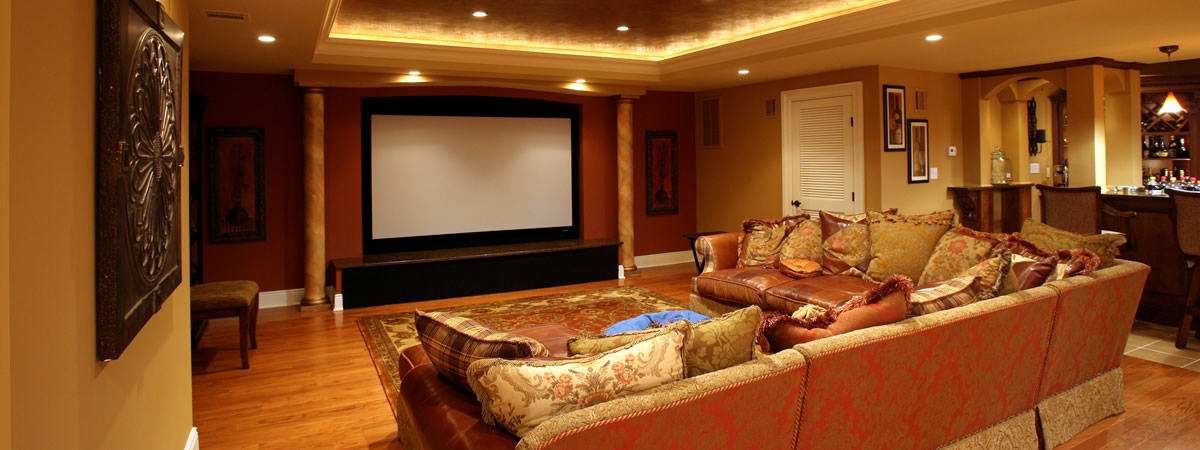
Home cinema, also called home theater or home theatre, refers to home entertainment audio-visual systems that seek to reproduce a movie theater experience and mood using consumer electronics-grade video and audio equipment that is set up in a room or backyard of a private home. In the 1980s, home cinemas typically consisted of a movie pre-recorded on a LaserDisc or VHS tape; a LaserDisc or VHS player; and a heavy, bulky large-screen cathode ray tube TV set. In the 2000s, technological innovations in sound systems, video player equipment and TV screens and video projectors have changed the equipment used in home theatre set-ups and enabled home users to experience a higher-resolution screen image, improved sound quality and components that offer users more options (e.g., many of the more expensive Blu-ray players in 2016 can also "stream" movies and TV shows over the Internet using subscription services such as Netflix). The development of Internet-based subscription services means that 2016-era home theatre users do not have to commute to a video rental store as was common in the 1980s and 1990s (nevertheless, some movie enthusiasts buy DVD or Blu-ray discs of their favourite content).
Today, a home cinema system typically uses a large projected image from a video projector or a large flat-screen high-resolution HDTV system, a movie or other video content on a DVD or high-resolution Blu-ray disc, which is played on a DVD player or Blu-ray player, with the audio augmented with a multi-channel power amplifier and anywhere from two speakers and a stereo power amp (for stereo sound) to a 5.1 channel amplifier and five or more surround sound speaker cabinets (with a surround sound system). Whether home cinema enthusiasts have a stereo set-up or a 5.1 channel surround system, they typically use at least one low-frequency subwoofer speaker cabinet to amplify low-frequency effects from movie soundtracks and reproduce the deep pitches from the musical soundtrack.
INTRODUCTION
In the 1950s, playing home movies became popular in the United States with middle class and upper-class families as Kodak 8 mm film projector equipment became more affordable. The development of multi-channel audio systems and later LaserDisc in the 1980s created a new paradigm for home video, as it enabled movie enthusiasts to add better sound and images to their setup. In the mid-1980s to the mid-1990s, a typical home cinema in the United States would have a LaserDisc or VHS player playing a movie, with the signal fed to a large rear-projection television set. Some people used expensive front projectors in a darkened viewing room. During the 1990s, watching movies on VHS at home became a popular leisure activity. Beginning in the late 1990s, and continuing throughout much of the 2000s, home-theater technology progressed with the development of the DVD-Video format (higher resolution than VHS), Dolby Digital 5.1-channel audio ("surround sound") speaker systems, and high-definition television (HDTV), which initially included bulky, heavy Cathode Ray Tube HDTVs and flat screen TVs. In the 2010s, affordable large HDTV flatscreen TVs, high resolution video projectors (e.g., DLP), 3D television technology and the high resolution Blu-ray Disc (1080p) have ushered in a new era of home theater.
RECENT DEVELOPMENTS
In the 2000s, the term "home cinema" encompasses a range of systems meant for movie playback at home. The most basic and economical system could be a DVD player, a standard definition (SD) large-screen television with at least a 27-inch (69 cm) diagonal screen size, and an inexpensive "home theater in a box" surround sound amplifier/speaker system with a subwoofer. A more expensive home cinema set-up might include a Blu-ray disc player, home theater PC (HTPC) computer or digital media receiver streaming devices with a 10-foot user interface, a high-definition video projector and projection screen with over 100-inch (8.3 ft; 2.5 m) diagonal screen size (or a large flatscreen HDTV), and a several-hundred-watt home theater receiver with five to eleven surround-sound speakers plus one or two powerful subwoofer(s). 3D-TV-enabled home theaters make use of 3D TV sets/projectors and Blu-ray 3D players in which the viewers wear 3D-glasses, enabling them to see 3D content.
Home theater designs and layouts are a personal choice and the type of home cinema a user can set up depends on her/his budget and the space which is available within the home. The minimum set of requirements for a home theater are: a large television set or good quality video projector CRT (no new models sold in U.S.), LCD, Digital Light Processing (DLP), plasma display, organic light-emitting diode (OLED), Silicon X-tal Reflective Display (SXRD), Laser TV, rear-projection TV, video projector, Standard-definition television (SDTV), HDTV, or 3D-TV at least 27 inches (69 cm) measured diagonally, an AV receiver or pre-amplifier (surround processor) and amplifier combination capable of at least stereo sound but preferably 5.1 Channel Dolby Digital and DTS audio, and something that plays or broadcasts movies in at least stereo sound such as a VHS HI-FI VCR, LaserDisc player (no new stand-alone models of either are available; VHS VCRs are usually bundled in combo decks with DVD players), a DVD player, a Blu-ray disc player, cable or satellite receiver, video game console, etc. Finally a set of speakers, at least two, are needed but more common are anywhere from six to eight with a subwoofer for bass or low-frequency effects.
The most-expensive home-theater set-ups, which can cost over $100,000 (US), and which are in the homes of executives, celebrities and high-earning professionals, have expensive, large, high-resolution digital projectors and projection screens, and maybe even custom-built screening rooms which include cinema-style chairs and audiophile-grade sound equipment designed to mimic (or sometimes even exceed) commercial theater performance.